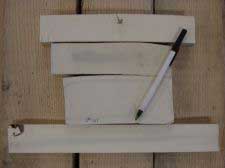Air Drying, Moisture Content, and Useability
How long will air-drying take to get wood to a stable moisture equilibrium? And would kiln-drying be better? September 6, 2010
Question
What is the moisture content supposed to be in red oak before you can make furniture with it? I have some oak that has been sawn for over half a year. It has been in a garage with no heat or much air movement since it was sawn. It is stickered with 1"by 1" boards every foot. How long will it take to be ready for production with just air drying? Also on a side note I was told by a cabinet guy to paint the end grain of the boards. Is this a good idea and if so is it too late to do it now?
Forum Responses
(Sawing and Drying Forum)
From contributor I:
You didn't say how thick these pieces were. The wood will eventually reach Equilibrium Moisture Content with its environment. 4/4 would probably be about as dry as it is going to get in your garage. 8/4 will probably need more time to reach EMC. The EMC for your garage is probably in 10-12% range. This is not dry enough to use in most interior applications which need 5-7%. You'll need to move the wood to a drier environment to finish it off or finish it in a kiln.
It's probably too late to benefit much from coating the ends but it may do some good as your wood still needs more drying. Most paints are designed to let moisture through so use paint that is designed to seal, and then use several coats. Coatings such as Anchorseal are designed specifically for this application and block moisture movement much better.
From the original questioner:
I did forget to mention the boards are 4/4 thick. Also how long would they have to be kiln dried if they have been sitting and air drying for seven months? For what it’s worth the log had been cut down 2-3 years before it was sawn. Does that affect anything as far as how fast it dries?
From contributor Y:
I have a Nyle 50.Your load would likely take two and a half weeks to get down to 6%. If you can get your lumber kilned you would likely be happier with the results. You don't want to end up not satisfied with your job.
From Gene Wengert, forum technical advisor:
The key is getting the correct MC, whether it is air dried and then moved into a drier shop or put into a kiln to achieve the low MC’s. Do you know the MC? Maybe it dried to a low MC in your shop. There are advantages to kiln drying versus shop drying – it’s faster, kills any insects and the eggs, lowers MC often and no insects are brought into the shop and humidity does not increase in the shop. Having said that, I put my lumber in my attic and let it dry to 6% MC there and get hot enough to kill insects too. Of course, it is just a few pieces, as the weight of a large load could break the rafters or trusses.
From contributor R:
I mean no disrespect to anyone here, but I exclusively use air dried wood here in KS and have only ever had two issues with moisture content and both of them were directly attributable to poor construction techniques. Depending on your region the 5-7% numbers are unsustainable even in climate controlled houses. All that being said, I would check MC if you can, here in KS anything under 9% stays pretty stable but we have more humidity than other places. I would also consider planing both faces of the wood and restickering in a controlled or relatively controlled environment. Do all your final machining and assembly relatively quickly (don't machine tenons in February and mortises in June or you may have some issues down the road).
Finally, be aware of movement, even in kiln dried stuff wood moves, know that and how to address letting the wood move while maintaining structural and aesthetic integrity. Take a lesson from the Shaker style, which was designed to take advantage of the stability and instability of wood in furniture building.
From Gene Wengert, forum technical advisor:
Wood, kiln-dried or air dried, moves in service for only one reason and that is because its moisture is changing. If there is no MC change, there is no movement. The key is to get the MC at the time of manufacturing as close as possible to the MC that the wood will have in use. The link below gives the EMC for outside conditions in the USA. Note that almost all values are 12-13% EMC in the USA, including KS. Our body might tell us that it is humid, but the truth is different. In other words, our bodies do not estimate humidity very well. Regarding the interior EMC, if you heat outside air (without adding moisture) about 25 F when the air is close to 100% RH, you will achieve about 7% EMC.
The US Forest Products Lab has measured the MC of wood and wood products in homes throughout the USA and the interior values of 6-8% MC are common throughout most of the USA. This is true in the Midwest and other areas where winter heating is used. Someone can use (or claim to use) air-dried wood, but that does not give us the MC of the wood. Because it may have air-dried to 12% MC and then dried a bit more in a heated shop, the wood could be between 6-8% MC. Hence, they will have little moisture issues to deal with. Wood does not have to be kiln dried to achieve these low MC’s, but a kiln is quicker and has other advantages, as mentioned before.
